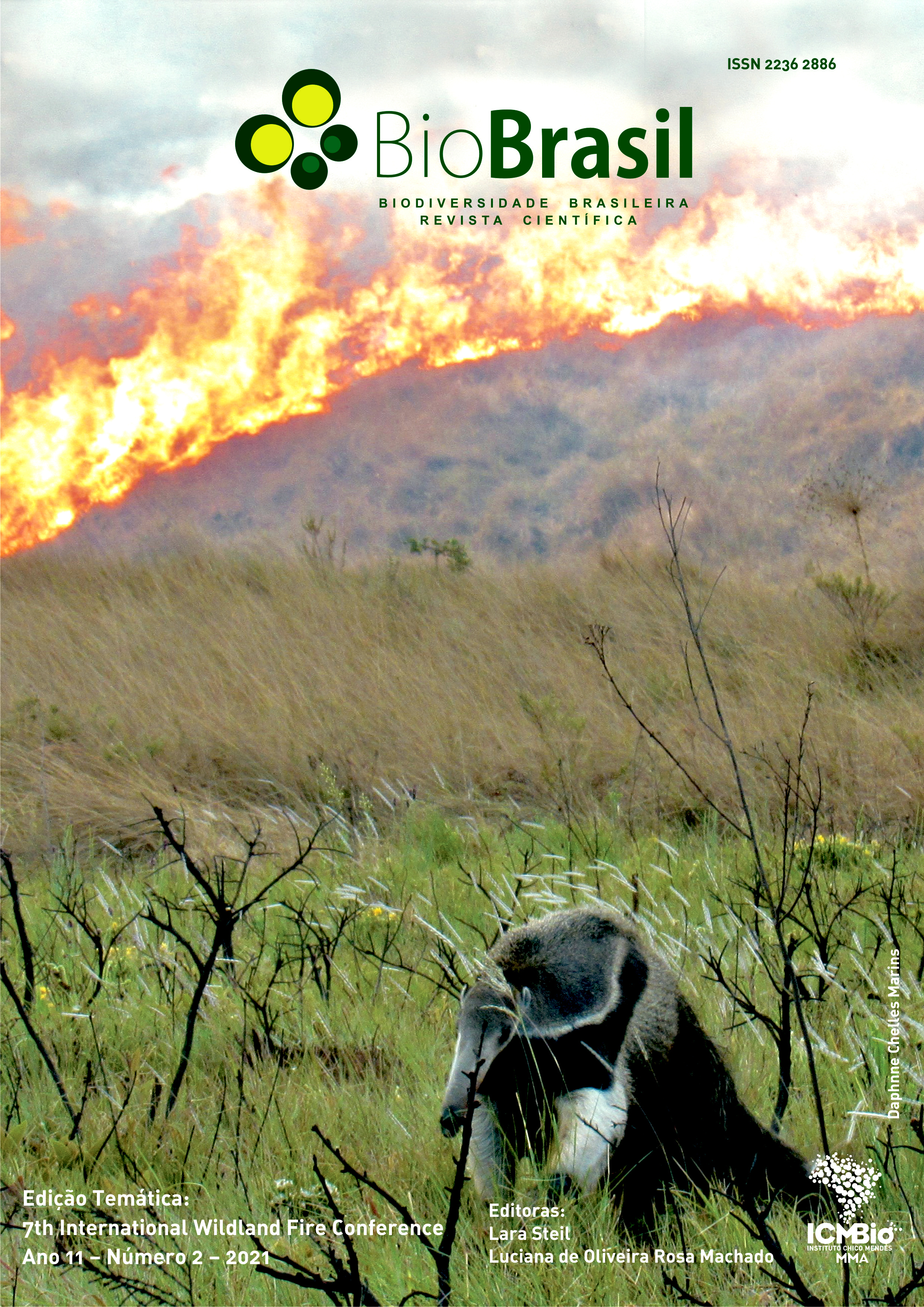Market-based Options for Supporting Sustainable Fire Management of Fire-prone Cerrado (Savanna) Remnant Landscapes
DOI:
https://doi.org/10.37002/biodiversidadebrasileira.v11i2.1725Keywords:
Fire regimes, wildfires, prescribed burning, indigenous fire managementAbstract
Sustainable fire management of remnant Cerrado (savanna) vegetation faces many challenges in Brazil and regionally, including: the legacy of imposed colonial fire suppression policies; massive fragmentation of the Cerrado biome through agricultural and pastoral development; loss of cultural fire management knowledge and experience; occurrence of severe late dry season wildfires given general lack of appropriate prescribed fire management. As context for addressing these challenges, we first provide illustrative examples of a successful market-based program implemented in fire-prone north Australian savannas, and recent establishment of a complementary pilot program in wildfire-prone savanna in Botswana. We then outline the need and opportunity for developing an analogous fire management approach in Brazilian Cerrado, noting that: (a) there is considerable potential for implementing supportive and incentivized fire management on frequently wildfireaffected lands, especially Indigenous Territories; (b) as demonstrated by Australian experience, such development can be achieved rapidly under conducive policy conditions. Perhaps the key to such rapid transformation is to recognise that everyone benefits - global climates, regional ecological sustainability, and local people both culturally and financially. The paper provides a contextual summary of presentations and technical workshop discussions associated with the conducting of a Special Session of the 7th International Wildland Fire Conference, Campo Grande, Brazil, focused broadly on the theme described by this paper's title.
Downloads
References
Ansell J et al. Contemporary Aboriginal savanna burning projects in Arnhem Land: a regional description and analysis of the fire management aspirations of Traditional Owners. International Journal of Wildland Fire, 29: 371-385, 2020.
Bowman DMJS & Panton WJ. Decline of Callitris intratropica in the Northern Territory: implications for pre- and post-colonisation fire regimes. Journal of Biogeography, 20: 373-381, 1993.
CoA (Commonwealth of Australia). Carbon Credits (Carbon Farming Initiative) Reduction of Greenhouse Gas Emissions through Early Dry Season Savanna Burning. Methodology Determination 2013. Australian Government. <http://www.comlaw.gov.au/Series/F2013L01165>. 2013.
CoA (Commonwealth of Australia). Carbon Credits (Carbon Farming Initiative - Emissions Abatement through Savanna Fire Management) Methodology Determination 2015. Canberra: ComLaw, Australian Government. <http://www.comlaw.gov.au/Details/F2015L00344>. 2015.
CoA (Commonwealth of Australia). Carbon Credits (Carbon Farming Initiative - Savanna Fire Management - Emissions Avoidance) Methodology Determination 2018. Department of Environment and Energy, Australian Government. < https://www.legislation.gov. au/Details/F2018L00560>.
Cook GD, Meyer CP, Muepu M & Liedloff AC. Dead organic matter and the dynamics of carbon and greenhouse gas emissions in frequently burnt savannas. International Journal of Wildland Fire, 25: 1252-1263, 2016.
DoEE (Department of Environment and Energy). Savanna fire management carbon farming framework. Commonwealth of Australia. . 2019.
Durigan G. Zero-fire: not possible nor desirable in the Cerrado of Brazil. Flora, 268: 151612, 2019.
Durigan G & Ratter JA. The need for a consistent fire policy for Cerrado conservation. Journal of Applied Ecology, 53: 11-15, 2016.
Schmidt IB et al. Fire management in the Brazilian Savanna: first steps and the way forward. Journal of Applied Ecology, 55: 2094-2101. 2018.
Silva LCR, Hoffmann WA, Rossatto DR, Haridasan M, Franco AC & Horwath WR. Can savannas become forests? A coupled analysis of nutrient stocks and fire thresholds in central Brazil. Plant and Soil, 373(1-2): 829-842, 2013.
Townsend SA & Douglas MM. The effect of a wildfire on stream water quality and catchment water yield in a tropical savanna excluded from fire for 10 years (Kakadu National Park, North Australia). Water Research, 38: 3051-3058, 2004.
UNU (United Nations University). The global potential of Indigenous Fire Management. Institute of Advanced Studies, United Nations University, Tokyo. <http://i.unu.edu/media/tfm.unu.edu/news/2151/Final-ReportFindings-Regional-Feasibility-Assessments-ISFMI.pdf>.2015.
van der Werf et al. Global fire emissions estimates during 1997-2016. Earth System Science Data, 9: 697-720, 2017.
Whitehead PJ, Russell-Smith J & Yates CP. Carbon markets and improved management of fire in north Australian savannas: identifying sites for productive targeting of emissions reductions. The Rangelands Journal, 36: 371-388, 2014.
Woinarski JCZ, Williams RJ, Price O & Rankmore B. Landscapes without boundaries: wildlife and their environments in northern Australia. Wildlife Research, 32: 377-388, 2005.
Ziembicki MR et al. Stemming the tide: progress towards resolving the causes of decline and implementing management responses for the disappearing mammal fauna of northern Australia. Therya, 6: 169-225, 2015.
Downloads
Published
Issue
Section
License
Copyright (c) 2021 Biodiversidade Brasileira - BioBrasil

This work is licensed under a Creative Commons Attribution-NonCommercial-NoDerivatives 4.0 International License.
Os artigos estão licenciados sob uma licença Creative Commons Atribuição-NãoComercial-SemDerivações 4.0 Internacional (CC BY-NC-ND 4.0). O acesso é livre e gratuito para download e leitura, ou seja, é permitido copiar e redistribuir o material em qualquer mídia ou formato.












